Dali (Kingdom)
The Kingdom of Dali ( Chinese 大理 國 / 大理 国 , Pinyin Dàlǐguo , 937 - 1253 ) of the Bai was located in the area of today's Yunnan Province in China .
history
It was founded by Duan Siping in 937 and was ruled by 22 consecutive kings until 1253 when it was destroyed by an invasion of the Mongol Empire . Its capital was Dali .
Chinese sources describe these peoples as dark-skinned, which today hardly corresponds to reality. In the year 836, the Tang Dynasty , increasingly threatened by traders on the Silk Road, banned the Chinese from dealing with "colored people", ordered the entire empire to wear Chinese clothing and banned foreign religions, which led to great unrest and revolts in China . In 900 a general by the name of Zhu Wen launched a coup and rose to be emperor, who was overthrown after nine years. The resulting empires were unable to hold the province. This is likely to have caused the formation of the kingdom of Dali by Nanzhao, who presumably commanded the military of the province of Yunnan. Similarly, in 938 the first Vietnamese Empire gained independence from China.
The Dali kingdom was preceded by the Nanzhao dynasty, which was overthrown in 902. Three dynasties quickly followed one another until Duan Siping seized power in 937 and founded Dali. Gao Shengtai forced the puppet king Duan Zhengming to abdicate and enter monastic life in 1095 and renamed the state Dazhong . Before his death, he returned power to the Duan family. Duan Zhengchun renamed the state Hou Li ("the Later Dali") the next year .
The 11th King of Nanzhao introduced Buddhism as the state religion . Ten of the 22 kings of Dali renounced the throne and became monks . Since 1274 (establishment of Sayyid Ajall ) it belongs to the province of Yunnan in China.
Language and people
The language of the empire was Tai, so this kingdom is seen as the origin of the northern Tai peoples and thus the Tai-Kadai languages . A group of barbarians, called Tai, appeared as early as the 2nd century of Chinese history. They were neighbors of the Miao, Yao, Dong and Zhuang, who were also classified as barbaric and who lived in today's neighboring Chinese provinces of Guizhou and Guangxi (possibly also Dong in Guangdong), so that some kind of relationship between these languages must be assumed.
The origin of the Dali is unknown, the largest group of Tai speakers now live in Thailand . Chinese scholars generally tend to classify these minority languages as Sinotibetan languages. Apart from a large number of loan words, however, this is excluded by European scientists and both Tai-Kadai and Miao-Yao are viewed as an independent language family. The dispute has not yet been resolved. As a result of the conquest, these peoples were largely absorbed by the Han Chinese.
structure
The political and religious center of the Kingdom of Dali was the area on Erhai Lake west of the Gaoligong Shan , in which the rulers established the prefecture Téngchōng with the capital Dali. This was administered by a prefect whose office was hereditary and reserved for the influential families living there. Téngchōng Prefecture stretched from the Longchuan River to the upper reaches of the Irrawaddy , forming the westernmost administrative unit and border region of the kingdom.
literature
- Lin-ts'an Li: A study of the Nanzhao and Dali Kingdoms in the light of the art materials found in various museums. Republic of China, Nankang, Taiwan 1967, OCLC 2186725 . (chinese, english)
- Angela F. Howard: The Dharani pillar of Kunming, Yunnan. A legacy of esoteric Buddhism and burial rites of the Bai people in the kingdom of Dali, 937-1253. in: Artibus Asiae vol. 57. 1997, ISSN 0004-3648 .
- Zhengnong Xia, Ci Hai Bian Ji Wei Yuan Hui: Cihai ( Sea of Words ), Shanghai 1999, ISBN 7-5326-0839-5 . (Chinese)
Web links
- Kings of Dali 大理 938–1254 on chinaknowledge.org
- Nanzhao State and Dali State (The States Nanzhao and Dali) ( Memento of 19 February 2006 at the Internet Archive ) on dali.gov.cn
Individual evidence
- ↑ a b Yunnan Facts & Figures - History & Politics ( Memento of the original from May 17, 2014 in the Internet Archive ) Info: The archive link was inserted automatically and has not yet been checked. Please check the original and archive link according to the instructions and then remove this notice. at china.diplo.de, accessed on May 15, 2014.
- ↑ The Kingdom of Dali on chinahighlights.com, accessed on May 15, 2014. (English)
- ↑ Diana Kott: The first city on the outermost border - 4. The region of the river gorge fan as part of the kingdoms of Nanzhao and Dali (= dissertation, University of Göttingen) Göttingen 2003, OCLC 76494039 . Pp. 39-46.
